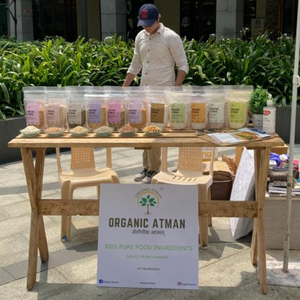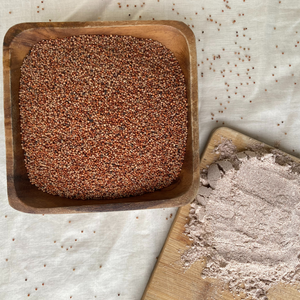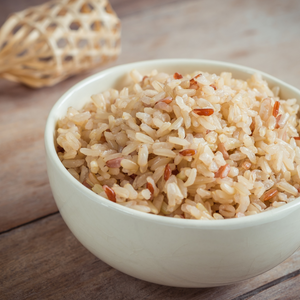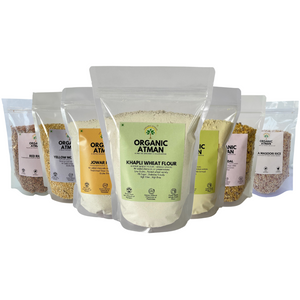
Have you heard of Paigambari Wheat? This ancient grain, also known as Sona Moti wheat, has been making a comeback in the health and wellness world. Let's dive into the history and benefits of this 4,500-year-old nutritional treasure.
Paigambari wheat is a reminder of India's rich agricultural heritage in a world where industrial farming and hybrid crops predominate. Cultivated since the Indus Valley Civilization, this ancient grain is enjoying a resurgence as eco-conscious farmers and health-conscious customers recognise its special advantages. Let's examine the reasons why Paigambari is more than simply a grain; it's a link to our history and a necessity for a more wholesome future.
What is Paigambari Wheat?
Paigambari Wheat is a type of ancient wheat that has been cultivated in the Indian subcontinent for thousands of years. is also known as Indian Dwarf Wheat, Gilgit Wheat, Multani, Rai Munir, Nikka, Sona Moti, Gundu Godi & Bol Gahu, Triticum sphearococcum probably originated from Bread Wheat (Triticum aestivum). It is known because of its resistance to yellow rust, drought tolerance, good yields, white flour, and mild taste. It was widely grown in the western regions of Punjab and Multan, as well as in portions of the Central Provinces (Madhya Pradesh) and United Provinces (Uttar Pradesh). This heritage grain is packed with essential nutrients and has been a staple in Indian cuisine for centuries.
What History Does Paigambari Wheat Holds?
Paigambari wheat (Triticum aestivum sphaerococcum) is one of India's oldest cultivated grains, dating back 4,500 years. Its semi-spherical, pearl-like grains gave it the titles Sona Moti (Golden Pearl) and Sugar-Free Gehu. It prospered because of its drought tolerance and resistance to yellow rust. However, British colonial mills, which were constructed for softer wheat varieties, pushed Paigambari to the brink of extinction. This heritage wheat is now reclaiming its position in Indian kitchens, thanks to initiatives and organic collectives.
For more thorough read, click here.
Why Paigambari Outshines Modern Wheat?
Paigambari Vs Modern Wheat

1. Nutritional Powerhouse
-
Low Glycemic Index (GI 55): Ideal for diabetics, Paigambari prevents blood sugar spikes.
-
Rich in Folic Acid: Rare among wheats, Paigambari wheat supports prenatal health and combats anemia.
-
40% More Protein & 267% More Minerals: Outperforms modern varieties like HD 2967 in zinc, iron, and magnesium.
-
Digestive-Friendly: Its simpler gluten structure reduces bloating, making it gentler on sensitive stomachs.
2. Environmental Friendly:
-
Drought-Tolerant: Thrives in rain-fed regions with minimal irrigation5.
-
Chemical-Free Farming: Naturally resistant to pests, it flourishes without synthetic fertilizer
3. Versatile in diet:
-
Soft Rotis & Flaky Parathas: Nutty-flavored flour perfect for traditional flatbreads.
-
Artisan Baking: Creates dense, flavorful sourdough and multigrain breads.
-
Hearty Porridges & Soups: Whole grains add texture to breakfasts and stews.
Health Benefits of Paigambari Wheat
Adding Paigambari Wheat to your diet can have numerous health benefits. From improved digestion to better heart health, this ancient grain offers a wide range of advantages.
-
Controls blood sugar: Low Glycemic Index (GI 55), ideal for diabetics
-
Supports prenatal health: Rich in folic acid
-
Fights anemia: Boosts iron levels naturally
-
Builds strength: 40% more protein than modern wheat
-
Boosts immunity: High in zinc and magnesium
-
Easy to digest: Simplified gluten structure reduces bloating
Challenges & Triumphs
Paigambari’s comeback hasn’t been easy:
-
Low Yield: Produces less than hybrid wheat, discouraging profit-focused farmers.
-
Niche Market: Limited awareness keeps demand low, though brands are bridging this gap.
-
Cultural Preservation: Tribal farmers in Madhya Pradesh, like the Bhil community, are now its custodians, blending tradition with organic practices.
Despite hurdles, success stories abound.
Why Choose Paigambari?
1) Paigambari Wheat addresses the current dietary difficulties like diabetes and gluten sensitivity.
2) It also promotes biodiversity while reducing the environmental impact of chemical farming.
3) Paigambari Wheat's each meal brings you closer to India's historic agricultural wisdom.
Buy Paigambari Whole Wheat and Paigambari Wheat Flour(Atta) at Organic Atman

Paigambari Wheat Whole (Paigambari Wheat Grains)
-
100% pure, unpolished grains
-
Rich in protein, fiber, and minerals
-
Sustainably sourced from small Indian farmers
-
Stone-ground for maximum nutrition
-
No synthetic additives or bleaching
-
Preserves natural flavor and aroma
















 Paigambari Wheat Flour(Atta)
Paigambari Wheat Flour(Atta)











